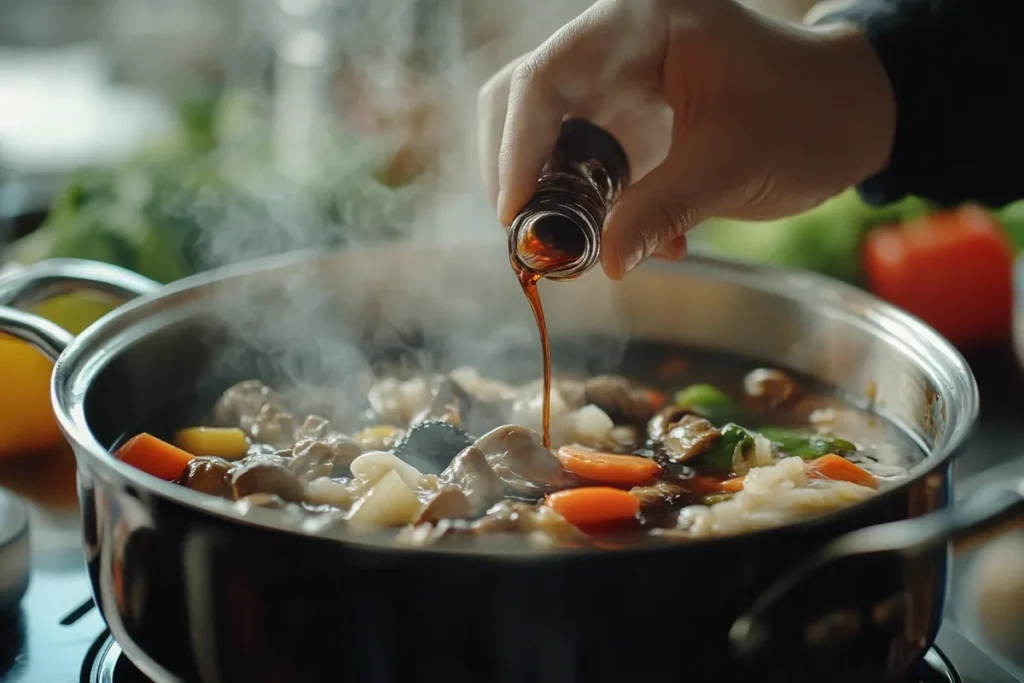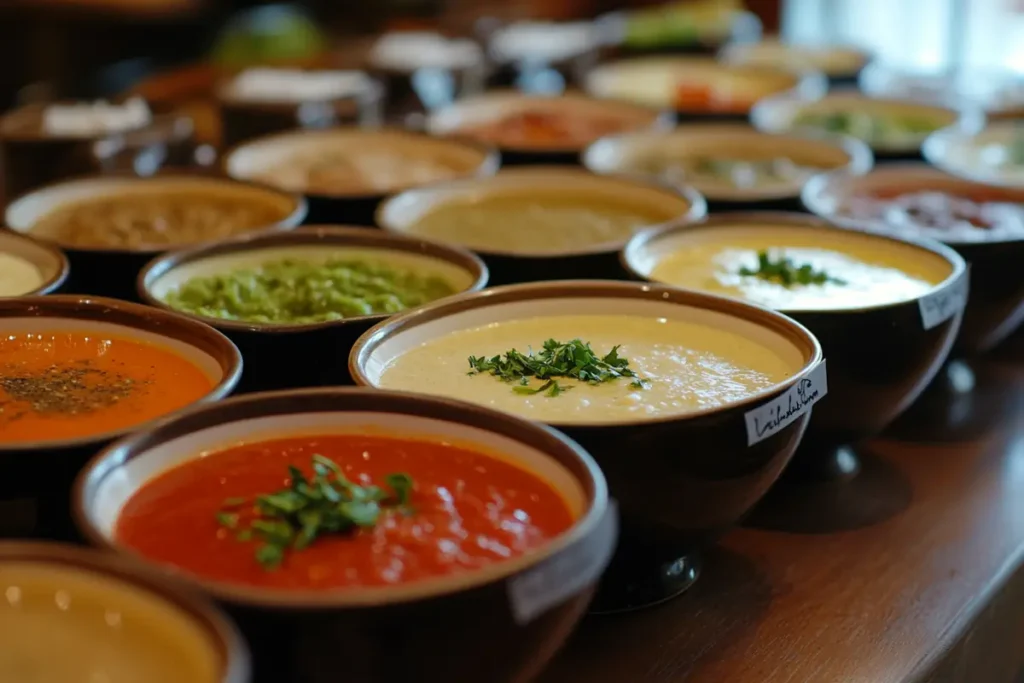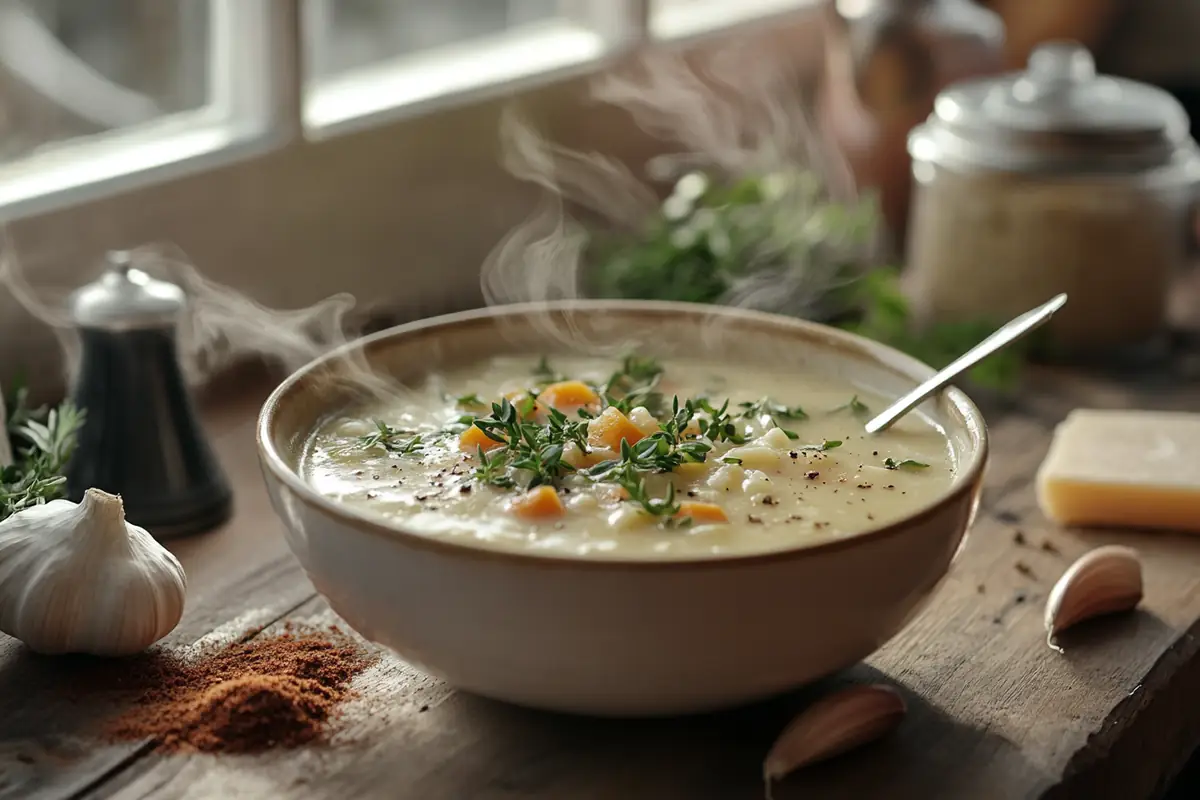What is the secret ingredient in soup? This question has intrigued home cooks and chefs for generations. Soup is a universal comfort food, loved across cultures and cuisines. But what makes a bowl of soup truly unforgettable? It’s often the secret ingredient that transforms a simple broth into a symphony of flavors.
This article dives into the magic of soups, exploring cultural traditions, scientific principles, and modern culinary twists that highlight the importance of those hidden elements. From umami-packed additions to aromatic herbs, we’ll uncover what makes soup irresistible. Let’s begin by unraveling the magic of soup and its hidden depths.
1: The Magic of Soup and Its Hidden Depths
Why Soup is a Universal Comfort Food
Soup has been a staple of human diets for centuries. It’s warm, nourishing, and endlessly adaptable. Whether it’s a hearty stew for a cold winter night or a light consommé for a sophisticated dinner, soups have a unique ability to evoke emotions. The beauty of soup lies in its simplicity—a few ingredients simmered together can create a dish bursting with flavor.
What sets soup apart from other meals is its ability to meld diverse elements into a harmonious whole. As it cooks, each ingredient releases its essence, creating a depth of flavor that’s hard to replicate in other dishes. This synergy is where the secret ingredient often works its magic, providing that extra touch of richness or brightness.
The Role of Secret Ingredients in Transforming Soup Flavor
The phrase “secret ingredient” might conjure up images of guarded family recipes or eccentric chefs adding a pinch of something mysterious. But in reality, a secret ingredient can be as simple as a splash of vinegar or a handful of fresh herbs. It’s the element that surprises your taste buds, leaving you wondering what made the dish so special.
Umami-rich additions like miso paste, soy sauce, or Parmesan rind can elevate a basic soup into something extraordinary. On the other hand, bright accents like lemon juice or fresh ginger can cut through richness, adding balance. By understanding the role of these hidden gems, you can take your soups from ordinary to unforgettable.

2: Exploring Popular Secret Ingredients Across Cultures
The Secret Ingredients of Traditional Soups
Every culture has its own spin on soup, often featuring a secret ingredient that makes it stand out. These hidden elements not only define the dish but also give it a regional identity.
- French Soups: Bouquet Garni and its Variations
French soups often rely on a bouquet garni—a bundle of herbs like thyme, parsley, and bay leaf tied together—to infuse aromatic flavors. It’s simple but works wonders in creating a rich, complex broth. - Asian Soups: Miso Paste and Fish Sauce
Asian cuisines excel at balancing flavors, and their soups reflect this mastery. Miso paste adds a fermented umami punch to Japanese soups, while fish sauce is a secret weapon in many Southeast Asian broths, giving them depth and saltiness. - Middle Eastern Touches: Preserved Lemon
Preserved lemons, common in Middle Eastern soups like harira, deliver a tangy burst of flavor that cuts through the richness of meat-based broths, making them irresistibly bright and savory.
Modern Twists on Classic Soup Enhancers
While tradition is inspiring, chefs today are reinventing soups with modern touches. Ingredients like coconut milk, smoked paprika, and even nut butters are becoming popular for their ability to transform a dish. For example, a splash of coconut milk can give a creamy texture without the heaviness of cream, while smoked paprika adds a subtle heat and smokiness.
For an inspiring twist, check out how Chopt Soup recipes experiment with vibrant vegetable-based broths.
3: The Science Behind Flavor: What Makes Soup Taste Better?
The Role of Umami in Soup Flavor
The fifth taste, umami, is key to creating a soup that feels hearty and satisfying. Umami-rich ingredients like soy sauce, Parmesan rind, or even anchovy paste work by enhancing other flavors, making the soup taste fuller and more complex. This is often what people refer to when they ask, “What is the secret ingredient in soup?”
- Natural Sources of Umami: Mushrooms, tomatoes, and seaweed are excellent sources for achieving that savory, mouthwatering taste.
- Layering Flavors for Maximum Impact: Adding umami ingredients at different stages of cooking ensures the flavors meld beautifully.
How Texture Plays a Role in Flavor Perception
Texture is often overlooked, but it’s just as important as taste. A well-blended soup feels luxurious, while chunks of vegetables or proteins can make it more satisfying. Thickening agents like potato, cornstarch, or even blended beans can add a creamy texture without heavy cream. This balance of smooth and chunky textures makes a soup truly memorable.
By experimenting with different ingredients and techniques, like those in the Best Ways to Add Flavor to Alfredo Sauce, you can craft soups that surprise and delight.
4: The Top 10 Secret Ingredients That Change the Soup Game

Aromatics: Garlic, Ginger, and Shallots
Aromatics are the backbone of any great soup. Adding garlic, ginger, or shallots early in the cooking process infuses the broth with a fragrant depth that sets the stage for bold flavors. Garlic adds warmth, ginger provides a zesty kick, and shallots balance with their mild sweetness.
For instance, a simple miso soup becomes extraordinary when ginger is sautéed before adding the broth. Similarly, garlic and shallots can elevate a hearty vegetable soup into a rich and satisfying meal.
Unusual Additions: Parmesan Rind, Nutmeg, and Vinegar
The best soups often have a surprise element. Adding a Parmesan rind while simmering not only enhances umami but also gives a velvety finish to the broth. A dash of nutmeg adds a subtle warmth to creamy soups, while a splash of vinegar at the end brightens and balances flavors.
If you’re looking for creative ways to enrich your soups, you might also enjoy exploring the Chopt soup recipe, which focuses on layering unexpected flavors.
Herbs and Spices That Elevate Soup Flavors
Herbs like thyme, rosemary, or cilantro can add vibrancy to any soup, whether sprinkled fresh as a garnish or simmered for hours. Spices such as smoked paprika, cumin, or even a pinch of saffron introduce complex notes that transform the dish into something unforgettable.
Don’t overlook the importance of using fresh or high-quality dried herbs. They can make all the difference when achieving that elusive “Wow!” factor.
Dairy and Non-Dairy Options: A Creamy Boost
Creamy soups feel indulgent and comforting, but you don’t always need heavy cream to achieve this effect. Alternatives like coconut milk, blended cashews, or even Greek yogurt can create a luscious texture while keeping the soup lighter.
For more tips on adding flavor and creaminess to soups, check out the ultimate guide to ditalini recipes.
5: How to Choose the Right Secret Ingredient for Your Soup
Matching Ingredients with Soup Types
When deciding what is the secret ingredient in soup, the answer depends on the type of soup you’re making. For clear broths, umami-packed ingredients like miso or soy sauce can add depth without clouding the liquid. And For creamy soups, a hint of acid, like lemon juice or vinegar, balances the richness.
For hearty stews, go bold with smoked meats, anchovies, or even a spoonful of chili paste for a spicy kick. Matching the right ingredient to the soup’s base ensures a cohesive flavor profile.
Balancing Flavors Without Overpowering
Adding a secret ingredient is about enhancing, not overpowering, the natural flavors of the soup. Start with small amounts and adjust as you taste. For example, a little fish sauce can amplify umami without making the soup taste fishy.
If you’re interested in trying unique recipes that master flavor balance, take a look at the Din Tai Fung cucumber salad recipe, which highlights a perfect interplay of flavors.
6: FAQs About Secret Soup Ingredients
What is the Most Versatile Secret Ingredient?
When it comes to versatility, umami-packed ingredients like miso paste or soy sauce take the crown. These can be added to almost any soup to deepen its flavor without altering the dish’s identity. For example, adding soy sauce to a vegetable broth enhances its savory profile, making it more satisfying.
Whether you’re preparing a simple chicken soup or a creamy tomato bisque, these ingredients blend seamlessly, answering the question, What is the secret ingredient in soup?
Can Simple Ingredients Make a Big Difference?
Absolutely! Sometimes, the simplest additions have the most profound impact. A splash of vinegar or lemon juice added at the end of cooking can brighten a soup and balance heavy flavors. Similarly, tossing in a Parmesan rind while simmering brings a subtle creaminess and depth to the broth.
The beauty of these simple ingredients lies in their ability to complement rather than dominate, allowing the natural flavors of the soup to shine.
How Can I Enhance Soup Without Adding Calories?
Low-calorie options like fresh herbs, spices, or a dash of hot sauce can add bold flavors without increasing the calorie count. For instance, smoked paprika or a squeeze of fresh lime can elevate a basic lentil soup. You can also use aromatic vegetables like garlic, onions, and celery to infuse the broth with flavor during cooking.
Are There Any Regional Soups Known for Unique Ingredients?
Yes, many regional soups are defined by their unique secret ingredients. For instance, harira, a traditional Moroccan soup, is flavored with preserved lemons for a tangy twist. In Japan, miso soup relies on dashi, a broth made from kombu (seaweed) and bonito flakes, for its characteristic umami taste.
7: People Also Ask (FAQs)
What Are Common Secret Ingredients in Soup?
Common secret ingredients include umami boosters like miso paste, soy sauce, fish sauce, and Parmesan rind. These not only enhance flavor but also add complexity to the broth. Fresh herbs, citrus zest, or even a pinch of nutmeg can transform a dish, giving it that “something special.”
How Do Chefs Enhance Soup Flavors?
Chefs often layer flavors by starting with a base of aromatics like onions, garlic, and celery. They then add depth with umami-rich ingredients, balance with acidity (lemon juice or vinegar), and finish with fresh herbs or a drizzle of high-quality olive oil for a polished taste.
Why Does Adding Acid Improve Soup Flavor?
Acid brightens the flavors in a soup, making them more vibrant and balanced. Ingredients like vinegar, lemon juice, or even a splash of wine can cut through rich or fatty elements, preventing the soup from feeling heavy.
What Are Good Substitutes for Heavy Cream in Soup?
For a creamy texture without using heavy cream, try coconut milk, blended silken tofu, or even pureed potatoes. These options are healthier and provide a similar richness, making them excellent choices for dairy-free or lighter soups.
8: LSI and NLP Keywords for SEO Optimization
Why Keywords Matter for Soup Recipes
In digital content, keywords are like secret ingredients for search engine success. Just as a splash of vinegar or a pinch of nutmeg can elevate a soup, the right mix of keywords enhances the discoverability of your article. By carefully integrating LSI (Latent Semantic Indexing) and NLP (Natural Language Processing) keywords, you ensure your content ranks well and reaches the right audience.
Recommended Keywords for Soup Content
To optimize content about What is the secret ingredient in soup?, include a range of related phrases and topics. These can include:
- Soup flavor enhancers
- Natural umami sources
- How to make soup richer
- Best spices for soups
- Classic soup secrets
- Balancing soup flavors
- Homemade broth tips
By incorporating these terms naturally, you not only boost your article’s relevance but also provide readers with a richer, more engaging experience.
How to Use Keywords Effectively
- Place primary keywords in the title and introductory paragraphs for visibility.
- Distribute secondary keywords in headings and throughout the text.
- Avoid keyword stuffing; focus on seamless integration.
If you’re interested in other techniques to enhance recipes, check out Creative Recipes to Jazz Up Boring Dishes.
9: Conclusion: The Power of a Secret Ingredient
Unlocking the Flavor Potential of Soup
So, what is the secret ingredient in soup? It’s not just about one magical addition—it’s about understanding how ingredients work together to create balance and depth. Whether it’s the umami punch of miso paste, the brightness of lemon juice, or the warmth of smoked paprika, every ingredient plays a role in crafting a memorable dish.
Experimentation is the Key to Perfection
The best way to discover your soup’s secret ingredient is to experiment. Try new spices, test unconventional additions, and don’t shy away from layering flavors. Cooking is as much about creativity as it is about following a recipe.
For more inspiration, explore a variety of exciting recipes, like the Ultimate Guide to Creamy Soups and discover how small tweaks can make a big impact.

